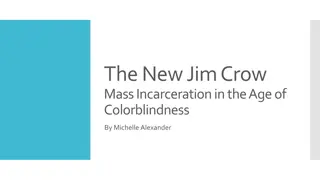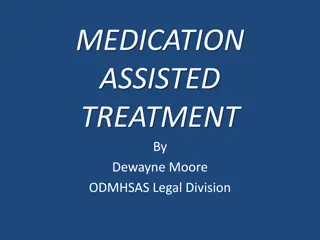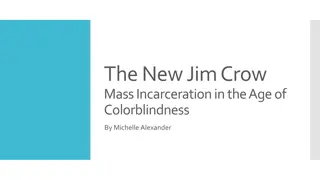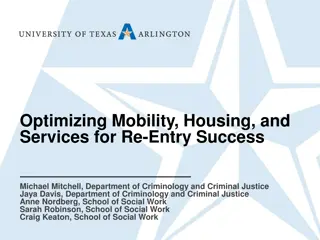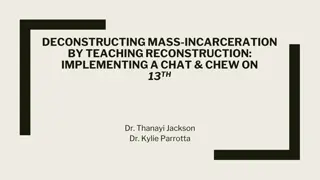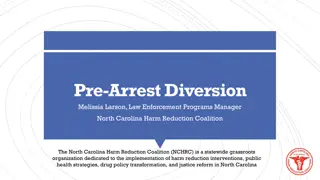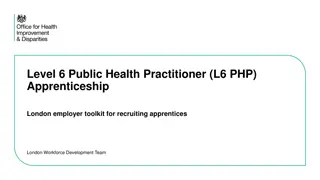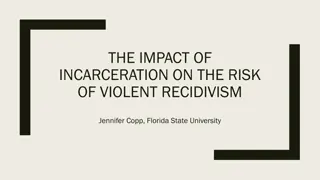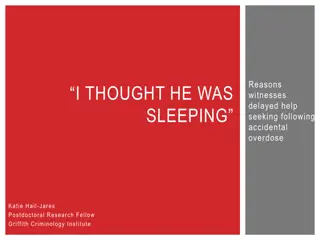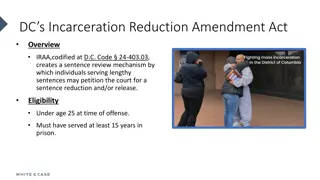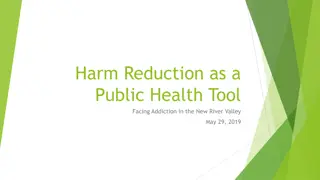Incarceration and Public Benefits
Exploring the concepts of incarceration, reentry obstacles for older adults, and the role of assistance in obtaining health care coverage and benefits for clients. The statistics show an increasing number of older inmates in state prisons, leading to challenges in their reintegration into society. Social security benefits play a vital role in supporting individuals through life changes.
Download Presentation

Please find below an Image/Link to download the presentation.
The content on the website is provided AS IS for your information and personal use only. It may not be sold, licensed, or shared on other websites without obtaining consent from the author.If you encounter any issues during the download, it is possible that the publisher has removed the file from their server.
You are allowed to download the files provided on this website for personal or commercial use, subject to the condition that they are used lawfully. All files are the property of their respective owners.
The content on the website is provided AS IS for your information and personal use only. It may not be sold, licensed, or shared on other websites without obtaining consent from the author.
E N D
Presentation Transcript
Incarceration & Public Benefits (Or, When Andy Dufresne is Your Client) February 2018
What does it mean to be incarcerated? Generally refers to someone who is involuntarily residing in a jail, prison, or other correctional facility Definition varies slightly by program
Vocabulary Jail: Usually a county jail, serving a sentence of 1 year or less Prison: State or federal prison, serving sentence of 1 year or more Probation: Community supervision, sentence withheld or an imposed and stayed sentence, supervision conditions set Parole: Wisconsin Parole Commission has released an individual from prison and set their conditions of parole (only for offenses committed before 12/31/99) Extended Supervision: Prison sentence completed, followed by community supervision (length set by judge at sentencing), also has supervision conditions
Statistics Between 1993 and 2013, the number of state prison inmates age 55 or older increased 400% Since 2003, inmates age 55 or older have been the fastest growing age group Why is this happening? Greater proportion of inmates sentenced to, and serving longer periods in state prison Increased number of older individuals admitted to state prison *Source: Bureau of Justice Statistics, Aging of the State Prison Population, 1993-2013
Reentry Obstacles for Older Adults Increased rates of homelessness Low employment ability Fewer community and family ties More likely to have chronic medical conditions
EBS Role Assist clients with obtaining health care coverage and other benefits Explain programs, including eligibility and reporting requirements Explain the basics of health insurance, including finding a doctor, networks, and out-of-pocket costs Refer clients to other community resources for housing, employment, legal services, and other support
Social Security Benefits Beneficiaries have a duty to report changes to SSA within 10 days Move, change of address, enter/leave institution, violate condition of parole, enter nursing home Retirement benefits and SSDI are suspended if the recipient is incarcerated for more than 30 continuous days Benefits to spouse and/or children will continue as long as they remain eligible Benefits can be reinstated the month following the month of release SSI payments are also suspended while the recipient is incarcerated If confinement lasts > 12 months, a new application for benefits will be required Benefits can be reinstated in the month of release
Eligibility for SSA Benefits DOC halfway house counts as incarceration for SSA purposes Ankle bracelet does not count as incarceration Chapter 51 or 55 commitments do not count as incarceration for SSA purposes
Reinstating Social Security Benefits Reinstatement process (or application process) can be started while incarcerated Some institutions have a prerelease agreement with local SSA office Inmates can also contact SSA when they know their anticipated release date to set up an appointment with the local office Reinstatement requires a copy of release documents If the individual was not receiving benefits before incarceration or SSI benefits terminated, they will need to file a new application
Example Andy received SSI benefits before he was sentenced to 3 months in jail on June 7, 2017. He was released on September 7, 2017 and his SSI benefits were reinstated as of September 7, 2017. Andy will be eligible for a partial payment for September and full benefits for October. If Andy had been incarcerated for more than a year, he would need to file a new application for SSI benefits.
Example Brooks received SSDI before he was convicted of a crime and sentenced to prison on May 15, 2015. His benefits were suspended effective May 2015. On October 10, 2017, Brooks was released from prison. His benefits were reinstated effective November 2017. Since Social Security benefits are paid in the month following the month for which they are due, Brooks will receive his November benefit in December 2017
Medical Care for Inmates Inmates in federal prison receive essential medical, dental, and mental health care (www.bop.gov) May be charged a copay for services they request (28 CFR 549.70) Inmates in WI state prisons receive necessary medical, dental, or nursing services ( DOC 316.03) Charged a copay for services they request ( DOC 316.04) For jail inmates, the sheriff...shall provide appropriate care or treatment and may transfer the prisoner to a hospital or to an approved treatment facility (Wis. Stat. 302.38) Inmate is liable for cost of care outside the jail; county shall pay the Medicaid rate if inmate is unable to afford the costs The government agency paying the costs of medical care inside or outside the jail may charge the inmate for the costs of this care
Medicaid Federal law prohibits the use of federal Medicaid funds to pay for an inmate of a public institution even if they are otherwise eligible for Medicaid Does not include individuals on electronic monitoring at home or on parole or probation; also does not apply to residents of a halfway house if they have freedom of movement and association Two exceptions Pregnant women may apply for and receive BC+ Prenatal Program benefits while they are incarcerated Inmates who reside outside a public correctional institution for more than 24 hours, e.g., inpatient in a hospital, at any one time can qualify for Medicaid if they meet all other eligibility criteria (MEH 6.9, BC+ Manual 3.6) Remember that individuals can apply for backdated coverage within 3 months Individuals may apply for Medicaid at any time ( DHS 102.01(1))
Example Red, a state prison inmate, enters the hospital on October 5 and is discharged on October 7. A Medicaid application is submitted on October 7. While the application is being processed, he re-enters the hospital on October 10 and is discharged on October 15. The application is approved on October 16. Both the October 5-7 and October 10-15 inpatient hospital stays can be covered under the application submitted on October 7. If no application was submitted for these hospitalizations, Red has until the end of January to submit an application for backdated coverage, assuming all other eligibility criteria are met
Marketplace An individual is incarcerated if they are serving a term in prison or jail Does not include probation, parole, or home confinement Also does not include someone in jail who has not been convicted of a crime Incarcerated individuals are not eligible to enroll or continue enrollment through the Marketplace Exempt from paying individual shared responsibility payment for this time After release, individuals have a 60-day SEP to enroll in coverage Other members of the household should report any changes, e.g, change in income, as soon as possible
Note About Private Medical Insurance Exclusions vary by plan, generally no coverage for treatment received while incarcerated Definition of incarceration may include electronic monitoring, check plan documents!
Medicare - Rule Medicare generally does not cover services for incarcerated beneficiaries, including individuals who are: Under arrest, incarcerated, imprisoned, escaped from confinement, under supervised release, on medical furlough, required to reside in mental health facilities, required to reside in halfway houses, required to live under home detention, confined completely or partially in any way under a penal statute or rule (42 CFR 411.4(b))
Medicare - Exception Exception Medicare payments may be made for services provided to incarcerated beneficiaries when: State or local law requires those individuals to repay the cost of medical services they receive while in custody and The state or local government entity enforces the requirement to pay by billing and seeking collection from all individuals with the same legal status In WI, this includes people on bail monitoring, Huber, electronic monitoring, probation, parole, etc.
Rebut Medicare Presumption Appeal MSN or EOB denials of coverage Cite Wis. Stat. 302.38(2) which states that inmates are liable for medical costs outside of jail Advantage plans will consider the person to be living out of service area Get documentation from DOC that person has been released Call SSA to reinstate benefits For medical services for incarcerated person who is required to pay for their own care, providers should bill using QJ modifier
Medicare and Incarceration Under arrest Incarcerated Imprisoned Escaped from confinement Under supervised release** On medical furlough Required to reside in mental health facility Required to reside in halfway house Home detention** Confined completely or partially under penal statute or rule **Not in WI
Examples Tommy is serving a 6-month sentence in the county jail. During this time, he was admitted to a local hospital as an inpatient because he had appendicitis. Because the county is required to pay for Tommy s care if he cannot, and state law does not require the county to bill her for the cost of this care, Medicare will not pay. Heywood is sentenced to home confinement for 3 months. During this time he also needs to have his appendix removed and is admitted to the hospital as an inpatient. Heywood is responsible for his own medical costs, so Medicare may pay for his care; may have to appeal claim denial and prove that the exception was met.
Maintaining Medicare During Incarceration Premium-free Part A continues uninterrupted while someone is incarcerated Incarcerated individuals must continue to pay Part B and any Part A premiums in order to maintain coverage Coverage usually ends after 3 months without a premium payment Individuals who lose Part B coverage must wait until the General Enrollment Period to re-enroll; coverage begins July 1 Likely coverage gap if released after Initial Enrollment Period May also face LEP and owe money for unpaid premiums
Applying for Medicare while Incarcerated Incarcerated individuals who anticipate being released from jail/prison should enroll in Original Medicare Parts A and B To enroll in Part A and Part B, inmates should send a signed and dated letter to Social Security that includes their name, Social Security Number, clear statement that they want to enroll, and the date coverage should be effective. MSP Buy-In Program can get someone coverage without having to wait for GEP and benefits starting July Gets rid of penalties Does not get rid of arrearages
Medicare Parts C & D If incarcerated, the individual does not live within the service area of the plan 63-day SEP when released
Example Floyd turned 65 in November 2016 while he was in prison. During his IEP, his wife, who is his POA, signed him up for Part A. She did not sign him up for Part B, and she was not told that he would not be able to enroll when he was released. She sent several emails to SSA during this time with questions about his situation but received no response. Floyd was released in February 2017 to a halfway house in Madison. He did not have access to phone or internet, and he was not free to leave. He mailed a letter to Social Security explaining this and said that he was interested in enrolling in Part B. Floyd was released from the halfway house to home confinement in June 2017, and he is free to leave if he provides advance notice. He went to the local SSA office at the end of the month and requested retirement benefits and Part B. His Part B enrollment was denied, and he was told that he will have to wait until January 2018 to enroll for coverage beginning July 2018. How can you help Floyd obtain health insurance coverage? MSP eligibility? Equitable relief?
FoodShare FoodShare denies benefits if: Fleeing felon A probation or parole violator Drug felons Conviction within past 5 years Must agree to and pass a drug test within 30 days from either the filing date or the date that the member is notified of the drug testing requirement to be found eligible
Fair Housing Act Does the policy have a discriminatory effect? Is the policy necessary to achieve a substantial, legitimate, or nondiscriminatory interest? Is there a less discriminatory alternative? Statutory exemption for exclusion because of certain drug crimes
Federal Housing Assistance Programs Per HUD, owner must prohibit admission of: Any household member evicted in last 3 years for drug-related criminal activity Unless completed an approved, supv drug rehab or circumstances no longer exist Conviction for production of meth in federally assisted housing Owner has reasonable cause to believe member is currently engaging in illegal drugs State sex offender registry Pattern of alcohol abuse
Federal Housing Assistance Programs Per HUD, owner may establish additional standards to restrict admission of anyone whose habits and practices reasonably may be expected to have a detrimental effect on the residents or the project environment" Policy must be uniformly applied
Employment Employer can only refuse to hire qualified applicant because of arrest or conviction record for an offense that is substantially related to circumstances of particular job Facts are important Encourage honesty on job application
Employment WI open records laws CCAP disclaimer: Notice to Employers: It may be a violation of state law to discriminate against a job applicant because of an arrest or conviction record. Generally speaking, an employer may refuse to hire an applicant on the basis of a conviction only if the circumstances of the conviction substantially relate to the particular job. For more information, see Wisconsin Statute 111.335 and the Department of Workforce Development's Arrest and Conviction Records under the Law publication.
Resources SSA: What Prisoners Need to Know (https://www.ssa.gov/pubs/EN-05-10133.pdf) SSA: Entering the Community After Incarceration (https://www.ssa.gov/pubs/EN-05-10504.pdf) Dept of Workforce Development, Equal Rights Division (https://dwd.wisconsin.gov/er/) Department of Corrections (https://doc.wi.gov/Pages/Home.aspx) CCAP (https://wcca.wicourts.gov/)


